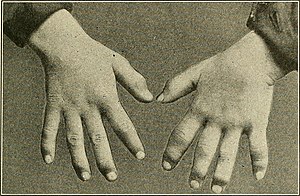Dactylitis
| Dactylitis | |
|---|---|
 | |
| Syphilitic dactylitis |
Dactylitis or sausage digit is inflammation of an entire digit (a finger or toe),[1] and can be painful.
The word dactyl comes from the Greek word "daktylos" meaning "finger". In its medical term, it refers to both the fingers and the toes.
Associated conditions[]
Dactylitis can occur in seronegative arthropathies, such as psoriatic arthritis and ankylosing spondylitis, and in sickle-cell disease as result of a vasoocclusive crisis with bone infarcts, and in infectious conditions including tuberculosis, syphilis, and leprosy. In reactive arthritis, sausage fingers occur due to synovitis.[2] Dactylitis may also be seen with sarcoidosis.
In sickle-cell disease it is manifested for the first time between 6-9 month old infants (as their protective fetal hemoglobin, HbF, is replaced with adult hemoglobin and the disease manifests) and is very often the presenting sign of the disorder.
References[]
- ^ "dactylitis" at Dorland's Medical Dictionary
- ^ Robbins, Stanley Leonard; Kumar, Vinay; Abbas, Abdul K.; Cotran, Ramzi S.; Fausto, Nelson (2010). "Robbins and Cotran pathologic basis of disease". In Vinay Kumar, Abul K. Abbas, Nelson Fausto. Robbins Pathology Series (Elsevier). p. 205. ISBN 978-1-4160-3121-5.
- Inflammations
- Rheumatology
- Orthopedic problems
- Medical sign stubs